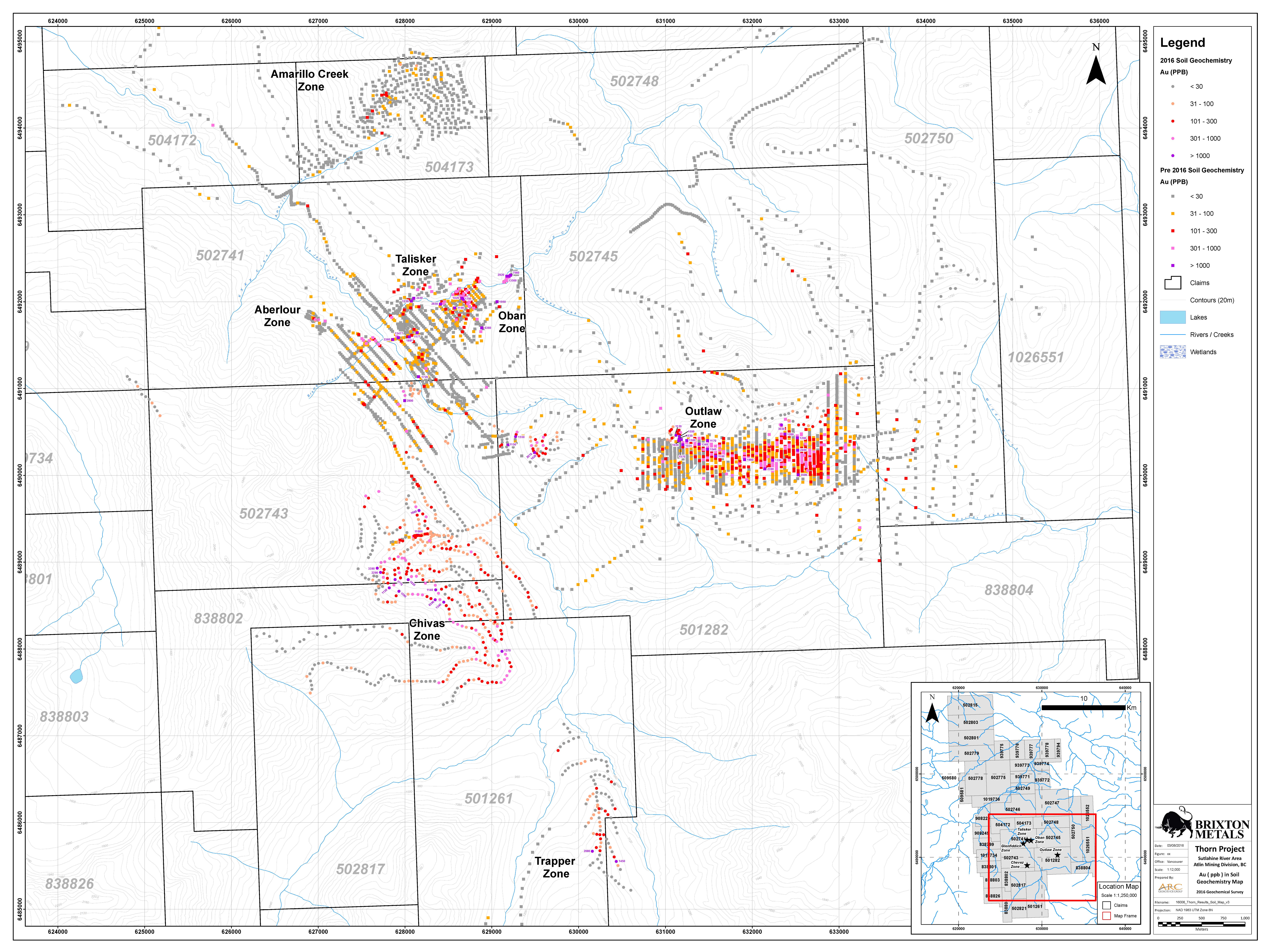August 5th , 2016 – Brixton Metals Corporation (TSXV: BBB) (the “Company” or “Brixton”) is pleased to provide results from the phase one exploration at its 100 percent owned Thorn gold-silver project located in Northwest British Columbia. The program was designed to test for gold mineralization in a previously unexplored section that is underlain by favourable geology on the 280 square kilometre property.
A total of 891 soils and 159 rock samples were collected during the phase one 2016 program at the Thorn project. The majority of samples were collected within a new area of the property which has not seen any previous exploration called the Chivas zone. Secondary areas sampled were the Outlaw, Aberlour, Trapper and Amarillo zones, where follow-up sampling was conducted based on encouraging gold results. Given the results further exploration work is planned.
Chairman and CEO of Brixton, Gary R. Thompson stated, “The Thorn project continues to show promise for both high grade gold and silver underground type targets and large scale open pit type targets. Geochemical surveys have shown to be an effective tool for identifying new mineralized zones. We are looking forward to further work at Thorn including geochemical surveys, geophysical surveys, geological mapping and drilling.”
The Chivas zone is a broad gold-in-soil anomaly of approximately 2.5 kilometers long and 1.9 kilometers wide and remains open in several directions (see the map at the link below). The highest gold-in-soil concentration was obtained from the Chivas zone, assaying 6.39 g/t Au or 6,390 ppb. From the 891 soil samples collected, 227 samples assayed greater than 100 ppb Au, 76 samples assayed greater that 300 ppb Au, 20 samples assayed greater than 1,000 ppb Au and 3 samples assayed greater than 3,000 ppb Au.
Please see the gold-in-soil map at the following link:
16006_Thorn_Results_Soil_Au_PPB_Map_v3

A one meter rock chip sample Q049457, contained the highest gold in rock concentration at 19.39 g/t Au and 136 g/t Ag within the Aberlour Zone. Rock grab sample Q049407 contained the highest silver in rock concentration at 2,240 g/t Ag with 1.16 g/t Au 9.4% Pb and 3.15% Zn within the Chivas zone. From the 159 rock samples 4 samples assayed greater than 3 g/t Au, 9 samples assayed greater than 1 g/t Au and 27 samples assayed greater that 0.3 g/t Au. Additionally, 3 samples assayed greater than 50 g/t Ag, 15 samples assayed greater than 10 g/t Ag, 42 samples assayed greater than 2.5 g/t Ag.
Please see the following link for gold-in-rock samples map:
16006_Thorn_Results_Rock_Au_PPM_Map_v3

Aberlour gold zone
The Aberlour zone is a high grade gold target. The mineralization is a structurally controlled zone of siliceous-sulphide rich material hosted by Stuhini mafic volcanics that appears to be 1 to 4 metres wide. The zone trends approximately 140 degrees and dips steeply with east-west cross structures. The zone is partly exposed in a recessive drainage for about 30-50 metres. A 2 metre chip sample in 2004 returned up to 57 g/t Au and 89 g/t Ag (2004 samples ranged between 4.26 g/t Au to 57.38 g/t Au). Sample Q049457 from the 2016 program was a one meter rock chip sample that returned 19.39 g/t Au and 136 g/t Ag. From the 7 rocks samples collected during this program at the Aberlour zone, 5 returned greater than 1 g/t Au,3 returned greater than 6 g/t Au. The next step is geological mapping further rock-soil sampling and drill testing. (see the insert on the gold-in-rock sample map at the link above)
Chivas gold Zone
The new Chivas zone was first identified and sampled in 2014 by a single 700 meter soil line which retuned up to 11 g/t Au. This recent work now represents the Chivas zone as a broad gold-in-soil anomaly approximately 2.5 kilometers long and 1.9 kilometers wide and remains open in several directions or an area greater than 5 square kilometres. The area is underlain by the favourable Stuhini group volcanics and the related Red-line unconformity boundary separating Jurassic clastic sediments. The next step is to collect additional soil and rock samples to infill and expand the anomaly, IP geophysical survey to cover the geochemical anomaly, geological mapping and drill testing.
Outlaw gold zone
Soil sampling extended the gold-in-soil anomaly to the north and northwest by about 150 meters and still remains open. Samples were collected to the north of where 2014 drill holes 127 (11.58m of 1.96 g/t Au) and 128 (59.65m of 1.15 g/t Au) intersected mineralization. Four soil samples from this program in this area returned greater than 1,000 ppb Au with a high of 1,550 ppb Au. The Outlaw zone is a sediment hosted gold-silver system with a 3.5 kilometre by 2 kilometre (7 square kilometres) gold-in-soil anomaly. This area is also related to the favourable red-line boundary (an unconformity between Triassic Stuhini group volcanics and Jurassic clastic sediments). The zone was first identified by Chevron Minerals in the early 1980’s. Next steps are drilling of 3000 to 6000 meters.
Soil samples or talus fines were frequently collected on contour at 50 meter stations, however in some areas where appreciable gossanous soils and or sulphide material were visible, sample density was increased.
All rock and soil samples were sent to the ALS Minerals preparation facility in Whitehorse, YT which is ISO9001:2008 certified. Soil samples were sieved to 180 microns (-80 mesh) and both fractions were retained. Rock samples were fine crushed to 70% nominal passing 2mm. They were then split using a riffle splitter into a 250g sample and pulverized to 85% passing 75 microns. Each sample was analyzed for ore grade Au and Ag using aqua regia extraction with an ICP finish. Over limits were further analyzed by fire assay with a gravimetric finish.
Mr. Gary R. Thompson, P.Geo., is a Qualified Person as defined under National Instrument 43-101 standards and has reviewed and approved this news release.
About Brixton Metals Corporation
Brixton is an exploration company focused on the advancement of its gold and silver projects toward feasibility.
The 280 square kilometre, 100% owned Thorn Project is located in northwestern British Columbia, Canada, approximately 105 km ENE from Juneau, AK. The Thorn project hosts a district scale Triassic to Cretaceous volcano-plutonic complex with many styles of mineralization related to porphyry and epithermal environments. Targets include sediment hosted Au-Ag, Ag-Au-Pb-Zn diatreme-breccia, Au-Ag-Cu veins; and volcanic hosted structurally controlled Au-Ag. Brixton has established a maiden inferred resource of 21.5Moz AgEq from 7.4 Mt at 89.75 g/t AgEq based on limited drilling. Further information regarding the Thorn Project, including resource estimates, can be found in the Company’s technical report prepared by SRK Consulting dated December 12, 2014 and filed on SEDAR.
The 100% owned Langis project and lands in the Cobalt Camp is 3,300 hectare in size. The project is located 500 km north of Toronto, Canada. The high-grade silver mineralization occurs as steeply-dipping veins within any of the three main rock types; Archean volcanics, Coleman Member sediments and Nipissing diabase. The Cobalt-Silver camp historically produced over 500 million ounces of silver with some reported assays reaching 9,000 oz/t Ag over 0.36 metres. The Langis mine produced 10.4 Moz Ag at 25 oz/t.
Brixton Metals Corporation shares trade on the TSX-V under the ticker symbol BBB. For more information about Brixton please visit our website at www.brixtonmetals.com.
On Behalf of the Board of Directors
Mr. Gary R. Thompson, Chairman and CEO
Tel: 604-630-9707 or email: info@brixtonmetals.com
Neither the TSX Venture Exchange nor its Regulation Services Provider (as that term is defined in the policies of the TSX Venture Exchange) accepts responsibility for the adequacy or accuracy of this release.
Information set forth in this news release may involve forward-looking statements under applicable securities laws. Forward-looking statements are statements that relate to future, not past, events. In this context, forward-looking statements often address expected future business and financial performance, and often contain words such as “anticipate”, “believe”, “plan”, “estimate”, “expect”, and “intend”, statements that an action or event “may”, “might”, “could”, “should”, or “will” be taken or occur, including statements that address potential quantity and/or grade of minerals, potential size and expansion of a mineralized zone, proposed timing of exploration and development plans, or other similar expressions. All statements, other than statements of historical fact included herein including, without limitation, statements regarding the exploration potential of the Langis property based on historical information resources estimates on the Thorn Project are forward looking statements. By their nature, forward-looking statements involve known and unknown risks, uncertainties and other factors which may cause our actual results, performance or achievements, or other future events, to be materially different from any future results, performance or achievements expressed or implied by such forward-looking statements. Such factors include, among others, the following risks: the need for additional financing; operational risks associated with mineral exploration; fluctuations in commodity prices; title matters; and the additional risks identified in the annual information form of the Company or other reports and filings with the TSXV and applicable Canadian securities regulators. Forward-looking statements are made based on management’s beliefs, estimates and opinions on the date that statements are made and the Company undertakes no obligation to update forward-looking statements if these beliefs, estimates and opinions or other circumstances should change, except as required by applicable securities laws. Investors are cautioned against attributing undue certainty to forward-looking statements.
